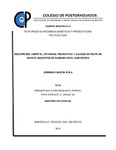Descripción varietal, potencial productivo y calidad de fruto de nuevos genotipos de durazno en el subtrópico
Abstract
La necesidad de variedades de durazno con mayor potencial productivo y calidad de fruto, hace indispensable la selección y evaluación de nuevos materiales. El estudio se realizó durante dos años, utilizando 14 nuevos genotipos de bajo requerimiento de frío. Para su descripción varietal se determinaron 48 caracteres estadísticamente significativos, 20 cualitativos, 15 cuantitativos y 13 pseudocualitativos, en la distinción de los genotipos evaluados. Se consideran que podrían ser de gran utilidad y orientación a programas de mejoramiento genético, agrupados en cualitativos: porte del árbol (AP) y forma del fruto (FF). En cuantitativos: tamaño del fruto (FTA), firmeza de la pulpa (FFP), tamaño del árbol (AT) y contenido de azúcar de la pulpa (FCAP). Finalmente, en pseudocualitativas: el color base interno (FCBP) y externo del fruto (FCB) y la época de maduración para consumo (EMC). Con respecto al potencial productivo y calidad de fruto, los nuevos cultivares presentaron brotación floral y foliar entre 16 y 74%; en amarre de fruto de 3.9 hasta 53.8%. El número de frutos fue de 9 a 578; el rendimiento por planta varió de 1 a 40.5 kg; el periodo de flor hasta madurez se cuantificó entre 97 y 143.5 días. El contenido de sólidos solubles totales osciló entre 10 a 19 °Brix; la concentración de ácido málico de 0.7 y 1.2%; el potencial de oscurecimiento entre 3.2 a 7.8. El tamaño varió desde 56 hasta 178.5 g; la forma se registró de 0.53 a 1.04; la firmeza de 2.5 a 7.5 kgf•mm-1 y el color externo presentó valores de luminosidad, croma y hue de entre 36 a 74, 20 a 40 y 32 a 76, respectivamente. ‘Blanquiña’, ‘Nuevo Azteca’, CP 04-08 y CP 03-04 W, presentaron mayor rendimiento; en calidad del fruto, la mayoría mostró excelentes atributos en tamaño, firmeza y un aroma especial en frutos de pulpa blanca. _______________ VARIETY DESCRIPTION, PRODUCTION POTENTIAL AND FRUIT QUALITY OF NEW GENOTYPES OF PEACH IN SUBTROPICS. ABSTRACT: Need for peach varieties with higher yield potential and fruit quality, makes indispensable evaluation and selection of new materials. The study was conducted for two years (2011-2013), using 14 new low-chill genotypes. In their varietal description, 48 statistically significant characters were determined: 20 qualitative, 15 quantitative, and 13 pseudoqualitative, for the distinction between the genotypes evaluated. It could be considered useful and appropriate guidance for breeding programs if characters are grouped as: qualitative characters: tree habit (AP) and fruit shape (FF); quantitative characters: fruit size (FTA), flesh firmness (FFP), tree size (AT) and flesh sugar content(FCAP); and finally, pseudocualitative characters: internal base color (FCBP) and outer fruit (FCB) and time of ripening and consumption (EMC). Regarding to production potential and fruit quality, productive behavior of budbreaking showed variations between 16 and 74%; fruit set was from 3.9 to 53.8%. The number of fruits per tree was from 9 to 578; resulting in fruit yield per tree from 1 to 40.5 kg; fruit development period was quantified between 97 and 143 days. Total soluble solids content ranged from 10 to 19 °Brix; acidity was 0.7 to 1.2%. Fruit size was from 56 to 178.5 g; registered fruit shape 0.5 to 1; firmness of 2.5 to 7.5 kgf•mm-1 and the external color values of lightness, chroma and hue between 36-74, 20-40 and 32-76, respectively. 'Blanquiña', 'New Azteca', CP 04-08 and CP 03-04 W, had the highest yields; in fruit quality, most showed excellent attributes in size and firmness, and a special aroma was perceived in white flesh selections.
Collections
- Tesis MC, MT, MP y DC [138]


